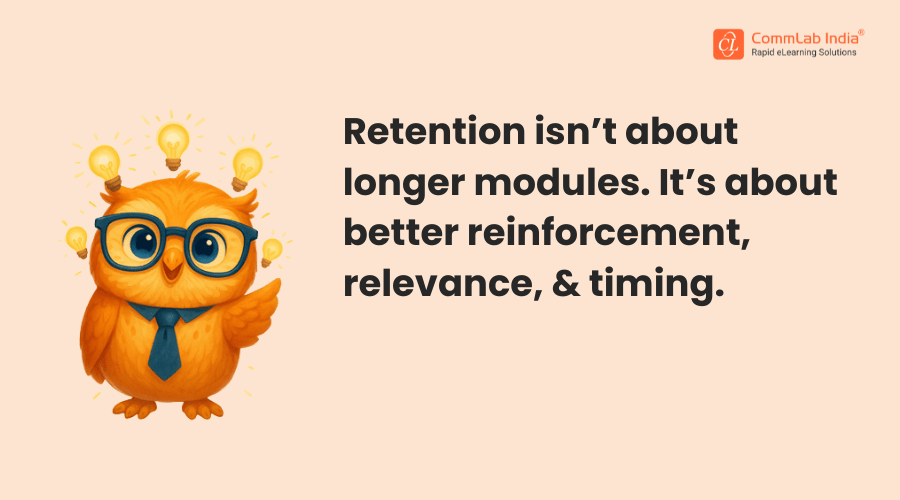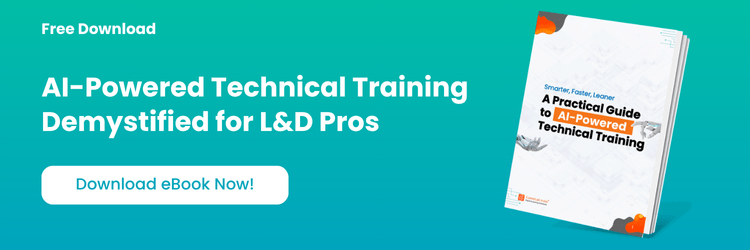Training that doesn’t stick is just noise. For sales and service staff, this is especially true. They don’t just need to know something—they need to use it, often in high-pressure situations with customers.
Unfortunately, most technical training still follows a one-and-done model: attend a session, complete a module, pass a quiz… forget everything a week later.
→ Download eBook: AI-Powered Technical Training
AI can change that, making learning faster, smarter, and more efficient.
When applied strategically, AI helps reinforce knowledge, personalize learning, and support real-world application, all of which are essential to make training stick.
Here’s how to do it.
Table Of Content
The Retention Problem in Sales & Service Training
Sales reps and service engineers operate in complex, dynamic environments. They’re asked to:
- Learn new products or protocols quickly
- Retain details about processes or compliance
- Apply that knowledge in real-time under pressure
But:
- 70% of knowledge is forgotten within a week (Ebbinghaus Forgetting Curve)
- 90% of training isn’t applied on the job without follow-up (ATD)
This isn’t a learner problem, it’s a design problem.
How AI Helps Retention
How AI Helps Retention in Technical Training
Reinforce Learning with these Tactics:
- Spaced Repetition
- Just-in-Time Support
- Role-Based Personalization
- Scenarios and Simulations
- Microlearning
Here’s how AI supports each:
1. Reinforcement Through Spaced Repetition
Tools like Qstream and MaxLearn use AI to deliver questions in timed intervals that align with how memory works.
- Learners get short quizzes 1, 3, 7, and 14 days after training
- AI adjusts based on performance—weak areas are repeated more often
- Nudges arrive via mobile or email to encourage recall on the go
2. Just-in-Time Support With Predictive Search
AI-enhanced knowledge bases (e.g., Guru, Notion AI) predict what users need based on:
- Job role
- Recent activity
- Common field queries
Sales reps can pull up objection-handling tips. Technicians can scan install checklists. All in seconds.
3. Role-Based Personalization
AI helps tailor training to:
- A new hire in support vs. a senior field engineer
- A rep focused on upselling vs. one doing tech demos
By analyzing behavior, AI can:
- Recommend refresher topics
- Suppress irrelevant modules
- Push targeted practice based on job tasks
4. Practice With Scenarios and Simulations
AI-generated scenarios and branching simulations allow learners to:
- Practice applying knowledge
- Get feedback on decisions
- Learn from mistakes in a safe environment
5. Microlearning, Reinforced by AI Nudges
Microlearning alone doesn’t ensure retention. But when paired with:
- AI-scheduled reviews
- Voice-based prompts (e.g., from tools like Spekit)
- Post-training roleplays
… it becomes part of a larger behavior change system.

Case in Point: Safety Compliance Training
A logistics company rolled out a new equipment handling protocol. In the past, training completion meant nothing—accidents still happened.
They used:
- ChatGPT to generate realistic error scenarios
- Qstream to reinforce safety decisions over 4 weeks
- A Slack-integrated chatbot that answered FAQs based on SOPs
Outcomes:
- 85% drop in repeated errors
- Retention scores stayed above 90% at 30-day mark
- Incidents decreased 22% compared to previous quarter
What to Avoid
AI is a booster, not a silver bullet. Be cautious of:
- Over-personalization that hides essential content
- Reinforcement without context (e.g., random quizzes with no job tie-in)
- Pushing too much, too often (learner fatigue)
Quick Wins You Can Deploy Now
- Use AI to write 10 post-training questions
- Load them into a spaced-recall tool (Qstream, MaxLearn)
- Create 3 role-based scenarios using ChatGPT
- Build a chatbot with key post-training questions
Then watch your completion and application rates rise.
Final Thought
Training that doesn’t stick is wasted time.
AI helps technical training teams design for the real goal: performance. Not just “knowing,” but doing—consistently, confidently, and correctly.
If you want your sales and service staff to remember what matters, give them AI-powered reinforcement that works the way they work.
In the end, the best training isn’t what learners complete—it’s what they retain.
View the original article and our Inspiration here


